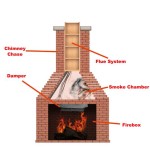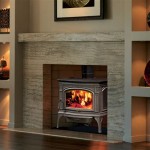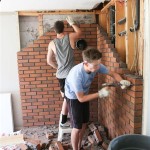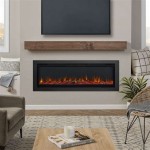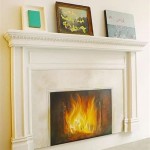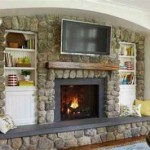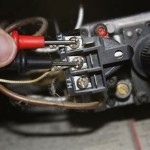How to Build an Outdoor Fireplace Chimney
Building an outdoor fireplace can significantly enhance your outdoor living space, providing warmth, ambiance, and a focal point for gatherings. A crucial component of any fireplace, especially one located outdoors, is the chimney. A properly constructed chimney effectively channels smoke and gases upward, preventing them from accumulating around your fireplace and potentially posing a fire hazard. This article will guide you through the process of building an outdoor fireplace chimney, emphasizing the importance of safety, proper materials, and adherence to building codes.
1. Planning and Design
Before embarking on construction, meticulous planning is essential. Start by considering the following factors:
- Fireplace Design: Determine the size and style of your fireplace and ensure it complements your outdoor space. The chimney's design should be compatible with the fireplace.
- Location: Choose a suitable location for your fireplace chimney, adhering to local building codes and fire safety regulations. Ensure adequate clearance from combustible materials and overhanging structures.
- Height: The chimney's height plays a critical role in effective smoke evacuation. Aim for a minimum height of 10 feet, but consult local codes for specific requirements.
- Materials: Select durable and fire-resistant materials for your chimney, such as brick, stone, or concrete blocks. Ensure they are compatible with your fireplace's construction.
- Access and Maintenance: Consider accessibility for cleaning and maintenance. A clean and well-maintained chimney is crucial for optimal performance and safety.
2. Foundation and Base
A sturdy foundation is essential for supporting the weight of the chimney. The foundation should be wider than the chimney base to distribute the load evenly. Follow these steps:
- Excavation: Dig a hole for the foundation, ensuring it is deep enough to reach undisturbed soil or frost line. The hole's dimensions should be wider than the chimney base by at least 6 inches on each side.
- Foundation Material: Use concrete, poured in place, or pre-cast concrete blocks. Ensure the foundation is level and plumb. Allow the concrete to cure completely before proceeding.
- Flashing: Install flashing around the base of the chimney to prevent water infiltration. Flashing is a thin, non-corrosive metal strip that directs rainwater away from the fireplace and chimney.
3. Chimney Construction
The construction of the chimney involves stacking and bonding the chosen building materials. Ensure that each layer is level and plumb. Consider the following points:
- Mortar: Use a high-quality, fire-resistant mortar, such as Type N or Type S mortar. Ensure it is mixed according to manufacturer instructions.
- Joints: Maintain consistent mortar joints throughout the chimney construction. Aim for a joint width of approximately 3/8 inch. Use a joint tool to ensure a uniform and aesthetically pleasing finish.
- Firebox Connection: Connect the chimney to the fireplace's firebox using a fire-resistant material like fireclay or cast iron. Ensure the connection is airtight.
- Lintel: Incorporate a lintel above the firebox opening to support the chimney's weight. The lintel should be made of a strong material like concrete or steel.
- Damper: Install a damper at the base of the chimney to regulate airflow and prevent drafts when the fireplace is not in use.
- Flue Lining: Install a flue lining inside the chimney to protect the chimney from heat and corrosive flue gases. The flue lining should be made of clay tiles, stainless steel, or other fire-resistant materials.
4. Chimney Cap and Termination
The chimney cap and termination play a vital role in preventing rain, snow, and debris from entering the fireplace system. They also contribute to proper draft and smoke evacuation. The following considerations are crucial:
- Chimney Cap: Choose a chimney cap made of weather-resistant materials like stainless steel or copper, and ensure it is properly secured to the chimney top. The cap should have a minimum 2-inch overhang on all sides.
- Termination: The chimney should terminate above any surrounding roofline to ensure proper draft. The minimum height should be 3 feet above the roofline or 2 feet above any point within 10 feet of the chimney, whichever is higher. Consult your local building codes for specific requirements.
5. Safety and Regulations
Building an outdoor fireplace chimney requires adhering to local building codes and fire safety regulations. Consulting with your local building department is necessary to ensure compliance. It is also important to consider:
- Fire-Resistance: Ensure all materials used in the construction are fire-resistant and meet the minimum standards set by local codes.
- Clearance: Maintain adequate clearance between the chimney and combustible structures, as per local codes. This clearance is crucial for preventing fire hazards.
- Inspection: After completion, have a qualified inspector examine your fireplace and chimney for compliance with building codes and safety regulations.
Building an outdoor fireplace chimney is a complex project that requires planning, skill, and adherence to safety regulations. By carefully following the steps outlined in this article, you can construct a durable, safe, and visually appealing chimney that will enhance your outdoor space for years to come.

How To Build An Outdoor Fireplace Today S Creative Life

How To Build An Outdoor Stacked Stone Fireplace

Stonetutorials Living Stone Masonry

How To Build An Outdoor Fireplace Step By Guide Buildwithroman

Stonetutorials Living Stone Masonry
:max_bytes(150000):strip_icc()/milkpaint-286c9ee63b604ca1aaecac5233c8a3f3.jpg?strip=all)
10 Free Outdoor Fireplace Construction Plans

How To Build An Outdoor Fireplace Firefarm Living

How To Build An Outdoor Fireplace Step By Guide Buildwithroman

Build An Outdoor Fireplace The Shed

How To Build An Outdoor Fireplace Firefarm Living
Related Posts

